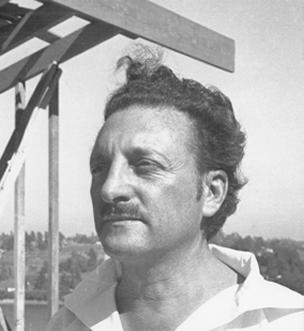
Rudolph Michael Schindler was an Austrian-born American architect whose most important works were built in or near Los Angeles during the early to mid-twentieth century.

Harvard Heights is a neighborhood in Central Los Angeles, California. It lies within a municipally designated historic preservation overlay zone designed to protect its architecturally significant single-family residences, including the only remaining Greene and Greene house in Los Angeles.
Ray Kappe was an American architect and educator. In 1972, he resigned his position as Founding Chair of the Department of Architecture at California State Polytechnic University, Pomona and along with a group of faculty, students and his wife, Shelly Kappe, started what eventually came to be known as the Southern California Institute of Architecture (SCI-Arc). In 2003, Kappe began working with LivingHomes to design modular homes.
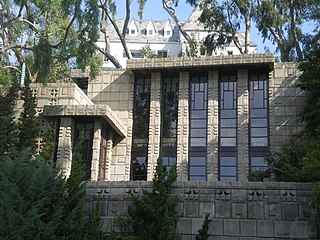
Storer House is a Frank Lloyd Wright house in the Hollywood Hills of Los Angeles built in 1923. The structure is noteworthy as one of the four Mayan Revival style textile-block houses built by Wright in the Los Angeles area from 1922 to 1924.
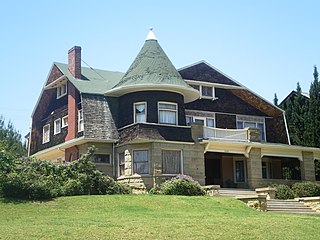
Alvarado Terrace Historic District is a designated historic district in the Pico-Union district of Los Angeles, California. It is located southwest of Downtown Los Angeles, along Alvarado Terrace between Pico Boulevard and Alvarado Street.

Los Angeles Nurses' Club is a clubhouse and apartment building for nurses located in the Westlake district of Central Los Angeles, California.

The Frederick Mitchell Mooers House, also known as the Wright-Mooers House, is an ornately detailed Victorian house built in 1894 at 818 South Bonnie Brae Street in the Westlake area of Los Angeles, California. It is named after the wealthy gold miner who owned the house from 1898 to 1900.

The Neutra Office Building is a 4,800-square-foot (450 m2) office building in the Silver Lake section of Los Angeles, California. The building was owned and designed by Modernist architect Richard Neutra in 1950. It served as the studio and office for Neutra's architecture practice from 1950 until Neutra's death in 1970. The building has been declared a Historic Cultural Monument and listed on the National Register of Historic Places. It was listed for sale in 2007 at an asking price of $3,500,000.

The North University Park Historic District is a historic district in the North University Park neighborhood of Los Angeles, California. The district is bounded by West Adams Boulevard on the north, Magnolia Avenue on the west, Hoover Street on the east, and 28th Street on the south. The district contains numerous well-preserved Victorian houses dating back as far as 1880. In 2004, the district was added to the National Register of Historic Places.
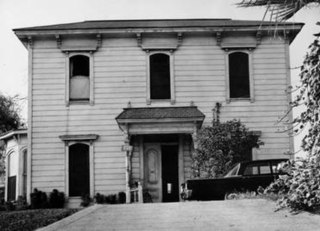
The Salt Box was a house built in the early 1880s in the Bunker Hill section of Los Angeles, California. Designed in the saltbox style that was popularized in New England, it was originally located at 339 South Bunker Hill Avenue. It was the home of physician Dr. A.G. Cook for most of the 1880s. In the late 19th century, Bunker Hill was one of the most prestigious neighborhoods in Los Angeles and was the site of many elegant Victorian homes. The Los Angeles Times wrote of old Bunker Hill: "Nowhere else in Los Angeles was the architecture so ornate. The mansions were wooden-frame Victorian with Gothic gingerbread touches applied with a heavy hand to simulate masonry." Though not as elegant as many of its Victorian neighbors, the Salt Box was "cherished by architecture students for the simplicity of its design."

Everett Phipps Babcock (1874–1928) was an architect who worked in the U.S. states of Washington and California.

The Sheats Apartments, also known as L'Horizon and sometimes mistakenly as the Sheets Apartments, is a historic eight-unit, multi-family building located at 10919 Strathmore Drive, in the Westwood neighborhood of Los Angeles, California. It is colloquially referred to as The Treehouse by UCLA students.

The Elkay Apartments is a historic five-unit two-story multi-family building located at 638-642 Kelton Avenue, in the Westwood neighborhood of Los Angeles, California.
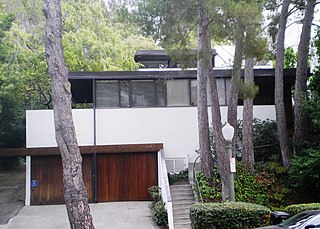
The Kelton Apartments is a historic four-unit two-story multi-family building located at 644-648 Kelton Avenue, in the Westwood neighborhood of Los Angeles, California.

The Strathmore Apartments is a historic 8-unit multi-family complex located at 11005-11013 1/2 Strathmore Drive in the Westwood neighborhood of Los Angeles, California. Notable past residents, amongst others, include John Entenza, Charles Eames, Ray Eames, Luise Rainer, Clifford Odets, and Orson Welles.

The Landfair Apartments is a historic two-building multi-family complex located on the southwest corner of Landfair Avenue and Ophir Drive in the Westwood neighborhood of Los Angeles, California. They were colloquially known as The Glass House and was renamed Robison Hall after UCHA member Everett Robison was drafted and killed in action in World War II.
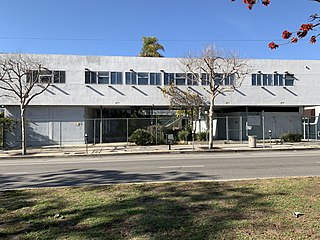
The Barry Building is a landmark commercial mid-twentieth century modern building located at 11973 San Vicente Boulevard in the heart of the Brentwood neighborhood of Los Angeles, California. It was designed by architect Milton Caughey (1911-1958) and completed in 1951. In 2007, the building was listed as a Los Angeles Historic-Cultural Monument,(Historical Cultural Monument #887), making it one of the few mid-century modern commercial buildings to gain such status. It was identified by the Los Angeles Cultural Heritage Commission as being a well-preserved and notable example of the California-style modern design. Despite this designation, the building's current owners received permission to demolish the building in 2019. As of March 2021, the building has not yet been demolished, however it is currently boarded up and vacant.
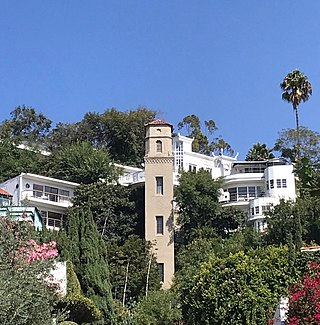
Hollywood Heights is a neighborhood in the Hollywood Hills of Los Angeles, bounded by the Hollywood Bowl on the north, Highland Avenue on the east, Outpost Estates on the west, and Franklin Avenue on the south. It includes a number of notable historic homes and buildings and has been home to numerous people in the film and music industries, dating back to the silent film era.

Douglas Rucker, is an American mid-century style architect and writer.



















